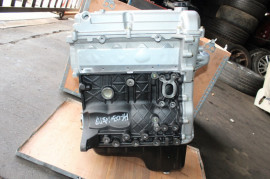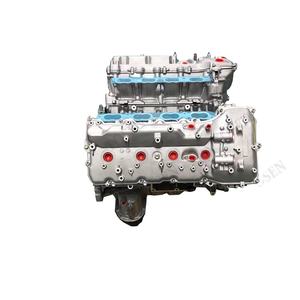Inexpensive Opel Corsa Engine Options for Your Budget
Inexpensive Opel Corsa Engine Options for Your Budget
Blog Article
Exploring the Inner Workings of a Compact Vehicle's Engine System
As vehicle drivers, we usually consider given the intricate procedures that occur within the boundaries of our automobile's engine system. The compact yet intricate machinery that moves us onward is a marvel of design precision and coordination. From the controlled surges in the combustion chamber to the meticulous timing of gas injection, every element plays a vital role in the smooth procedure of the engine. In this exploration of a compact lorry's engine system, we will certainly decipher the internal functions of this mechanical harmony, shedding light on the enigmas that drive us forward on our day-to-day journeys.
Combustion Process Summary
The burning procedure in a compact automobile's engine system is a critical system that successfully converts fuel into power to power the lorry. This process happens within the combustion chamber of the engine, where fuel and air mix, spark, and generate regulated explosions. The combustion process includes 4 major phases: intake, compression, exhaust, and power.
During the intake phase, the piston relocates downward, attracting in a mixture of air and fuel into the burning chamber. This descending activity generates the power needed to drive the car. This cyclic burning procedure is basic to the procedure of a small car's engine system, guaranteeing efficient energy conversion for propulsion.
Piston and Cylinder Interaction

The piston's accurate fit within the cylinder is vital for preserving ideal compression and protecting against power loss throughout burning. Tight clearances between the piston and cylinder wall surfaces make certain reliable securing, enabling the piston to move smoothly without allowing gases to leakage past. Correct lubrication is additionally essential to lower rubbing and use between these components, enhancing long life and efficiency.
Furthermore, the design and materials used in manufacturing the piston and cyndrical tube influence engine effectiveness and toughness. Modern engines commonly utilize light-weight yet durable products like aluminum alloys for pistons and cyndrical tube linings to decrease inertia and improve thermal performance. In general, the harmonious interaction between the piston and cylinder is fundamental to the engine's functionality and general efficiency.
Gas Injection System Performance
Fuel injection systems in small vehicle engines play a vital duty in exactly supplying fuel to the burning chamber for efficient and regulated ignition. The fuel injection system operates by injecting gas into the burning chamber at the optimum minute during the engine's procedure (opel corsa engine). This specific timing makes sure that the gas blends uniformly with the air for correct combustion, causing improved fuel performance and decreased exhausts
There are mainly two types of gas injection systems made use of in compact automobile engines: port fuel injection (PFI) and straight gas injection (DFI) PFI systems infuse gas right into the intake port prior to the consumption valve, while DFI systems inject gas straight right into the burning chamber. Both systems have their benefits, with DFI offering far better fuel atomization and PFI offering an extra cost-efficient option.
Recognizing Engine Cooling Devices
Reliable procedure of a small car's engine relies heavily on the performance of its cooling systems. The cooling system in a compact automobile typically website link is composed you can try this out of numerous parts working with each other to control the engine temperature. Understanding these engine air conditioning mechanisms is vital for preserving the efficiency and longevity of a portable car's engine system.

Exhaust System Elements Explained
The ideal functioning of a portable automobile's engine cooling devices depends upon a complementary system referred to as the exhaust system, which consists of various essential parts for guaranteeing effective discharges and engine efficiency. The exhaust system includes parts such as the exhaust manifold, catalytic converter, muffler, and tailpipe. The exhaust manifold gathers exhaust gases from the engine's cylinders and paths them to the catalytic converter. The catalytic converter then converts harmful contaminants in the exhaust into less harmful discharges prior to releasing them via the muffler and tailpipe.
One vital element of the exhaust system is the oxygen sensing unit, which keeps an eye on the oxygen levels in the exhaust gases to help control fuel consumption and make sure optimum engine performance. opel corsa engine. Furthermore, the resonator might be present in some exhaust systems to decrease sound degrees. In general, the exhaust system plays an essential duty in maintaining engine effectiveness, lowering hazardous exhausts, and ensuring a quieter driving experience for small web link automobile proprietors

Verdict
Finally, the compact lorry's engine system is a complex combination of elements that interact to promote the combustion process, convert fuel into energy, and remove waste gases. Comprehending the internal operations of the engine system, consisting of the piston and cyndrical tube interaction, gas shot system, engine air conditioning mechanisms, and exhaust system components, is essential for preserving ideal performance and effectiveness of the automobile.
The burning process in a compact automobile's engine system is an essential device that successfully transforms gas into energy to power the lorry.Gas shot systems in portable lorry engines play an essential duty in precisely supplying gas to the burning chamber for regulated and effective ignition.There are mainly two types of gas shot systems utilized in compact vehicle engines: port gas shot (PFI) and direct gas shot (DFI) Understanding these engine air conditioning mechanisms is vital for keeping the efficiency and durability of a small car's engine system.
The optimal functioning of a compact lorry's engine air conditioning mechanisms depends on a corresponding system recognized as the exhaust system, which comprises various important elements for ensuring reliable discharges and engine efficiency.
Report this page